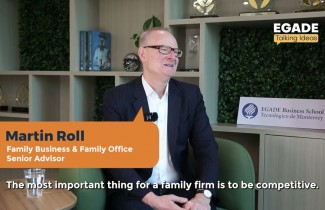Successful Transitions: How to Preserve Patrimony Without Losing Family?
Success relies on developing a shared vision of what the family business should become
Two of my close friends and successful family entrepreneurs said to me: 2Our dream is to be able to retire from the company in 10 years, while our wealth continues to grow and remains with our family but we don’t know if our children would want that”. I asked if they had shared this dream with them. They looked at each other and said, “Not exactly”.
This is because transition, unlike succession, means moving from one state or way of being to another; it is an intermediate step from what was before to what is after. Meanwhile, succession is the mere replacement of one person by another. Thus, having a transition in a family business inevitably involves a dialogue between generations and a process of "sustaining what has been earned" through family, business and society.
Ideally, a successful transition would have to preserve the legacy without sacrificing family. Many families preserve their wealth, but working together is a living hell. Many others let their wealth dissolve because they don't want to clash with each other, but in the end, they also blame each other for not holding on to that wealth. So how do you make a successful transition?
This requires the development of a shared vision of what the family business should become in the future. Neither the company's vision nor the family’s vision, but what the family hopes for their future and their wealth. It is the continuation of the dreams of different generations. This vision must be built, discussed and agreed upon for the family, and is usually done within the family council.
Based on this shared vision of the future, the family must set a plan as to the growth of the next generation. However, it must not be imposed by the generation in charge, but rather one that takes into account the expectations and goals of the family members who belong to the next generation and one that contributes to the shared vision. The transition plan must be based on the competencies (knowledge, skills and attitudes for successful performance) that the family members want to develop which are not necessarily the same for everyone.
If you are a member of the upcoming generation, you should ask yourself the following questions when developing your transition plan:
- What are my concerns and goals?
- What are the skills required to contribute to this shared vision of the family business?
- What are my existing competencies?
- Based on the gap between what is required and what I currently have, what should be my plan?
People tend to only focus on the next generation, but as we have already stated, the transition is a cross-generational matter, so a project to achieve the fulfilment of the older generation must also take place. This project is a good way to properly handle emotional and psychological conflict, which usually arises from the predecessors’ loss of power.
The main question you should ask yourself is: What will be my new role in the family business and in which project will I reach my full potential while contributing to the shared vision?
Lastly, it is necessary to have the tools to facilitate the integration of knowledge between generations. Why is it that some members of the younger generation want to continue the family business while others don't? The answer to this question has to do with formal and informal practices that the family business carries out with the younger generation from the time they are children until they work and contribute productively to the family business.
So you must build links so that the love and identity that are part of your legacy and heritage are kept alive. You must ask yourself:
- What am I doing to help my children internalize our values and experience the family business? (E.g. telling stories and anecdotes, letting the children play and have fun in the family business)
- How do I empower college-age children to learn how to solve problems, brainstorm and build their self-confidence? (E.g. undertaking an entrepreneurial project during the summer)
- How do I encourage young adults to learn the "know-how" of leading the family business? (E.g. sharing and strengthening the family's network)
To sum up, here are some interesting figures from the Familia Empresaria IFEM report1, which illustrates the challenges we face as entrepreneurial families in Mexico and Latin America:
- 68% of entrepreneurial families either do not have a shared vision or it is informal.
- 86% do not have a transitioning plan for the next generations.
- 74% do not plan for the future of the senior generation.
- 71% have no system for sharing knowledge between generations.
1This report, better known as La Radiografía, is a survey conducted by the Instituto de Familias Empresarias del Tecnológico del Monterrey (IFEM) with the participation of more than 1050 business leaders from Mexico and Latin America.



